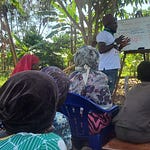A. Succession
- Bare land → grasses → shrubs → trees → mature forest.
- Design Application: Accelerate succession with pioneer species, agroforestry. Syntropic agroforestry
“A forest grows on a fallen forest” Geoff Lawton
B. Decomposition - nutrient cycling
- Fungi, bacteria, and detritivores break down organic matter into nutrients.
- Design Application: Composting, mulch, no-till gardening.
C. Water Cycling
- Evaporation → condensation → precipitation → infiltration.
- Design Application: Rainwater Harvesting, Keyline Design, Ponds.
D. Pollination & Seed Dispersal
- Animals, wind, insects, and water spread life.
- Design Application: Plant for pollinators, seed-saving, wildlife corridors.
E. Stacking
Nature is 3-dimensional, stacking in both time and space
Design Application: Food forests outperform monocultures every time
F. Symbiosis
Nature is typified by mutually beneficial relationships
From the lichen to the nitrogen-fixing root bacteria, or the mycorrhizal net.
Design Application:
G: Elements in systems perform multiple functions
Create an interlocking web of functionality by selecting those elements that offer multiple functions
Design Application: Trees offer shade, build soil, create habitat for other elements whilst producing yields of their own, e.g. fruits, timber, leaves.
Question: Can you list some of the many functions of the Moringa tree?
H: Support key functions with multiple elements.
The key to building resilient systems is to build in redundancy
Identify the essential functions of your designed system, and reinforce with multiple strategies
Design Application: Function = Water catchment.
Elements - water tanks and gutters, swales and soakaways, check dams, berms and banks, remediation of gullies and rills. Ponds, dams, and key lining, contour planting with deep-rooted plants and trees, such as Vetiver hedges. Forestation of higher slopes, controlled grazing, pathways and field boundary placement. etc.Edges - Unique circumstances can arise at the edges. The edge is the frontier between one system and another
Conclusion
Nature is the ultimate teacher. By observing and mimicking its principles, patterns, and processes, we can design systems that are not just sustainable but regenerative.














Share this post